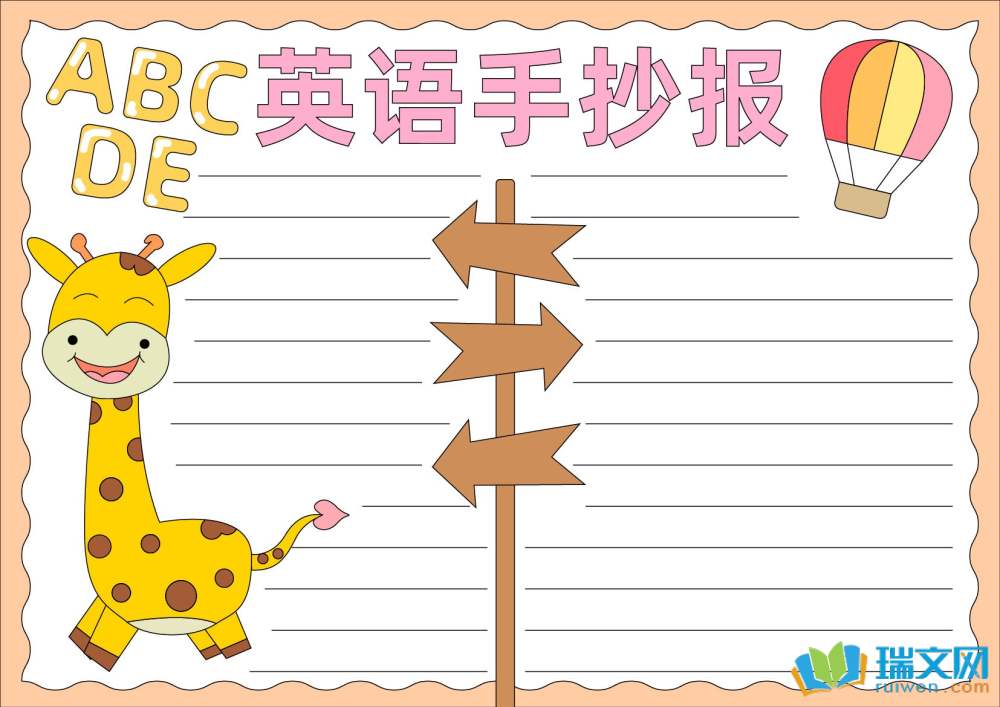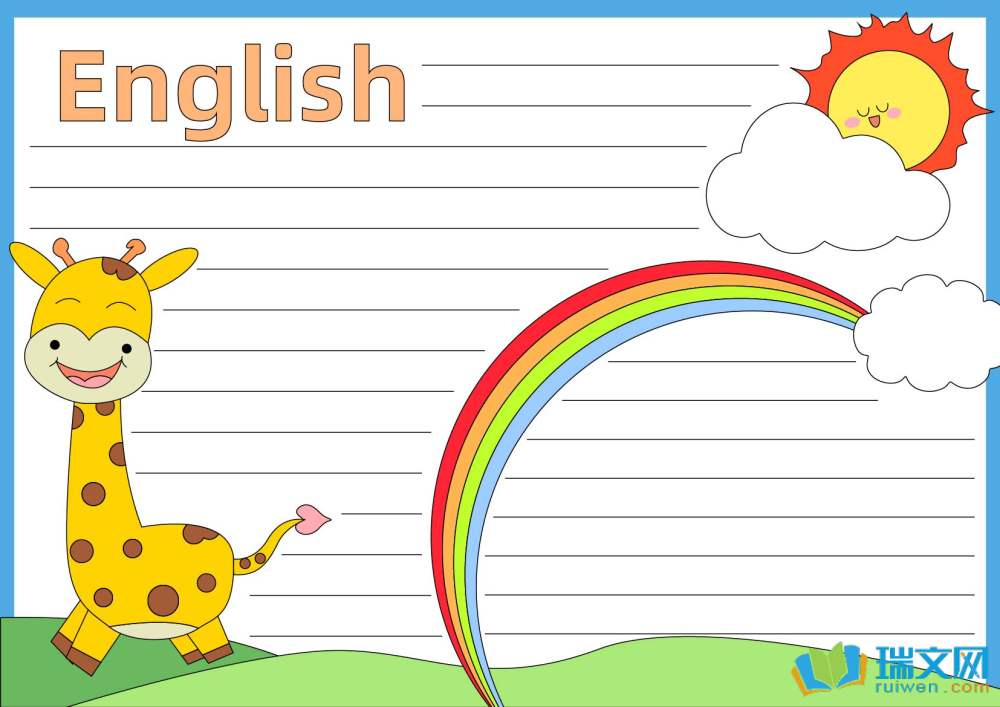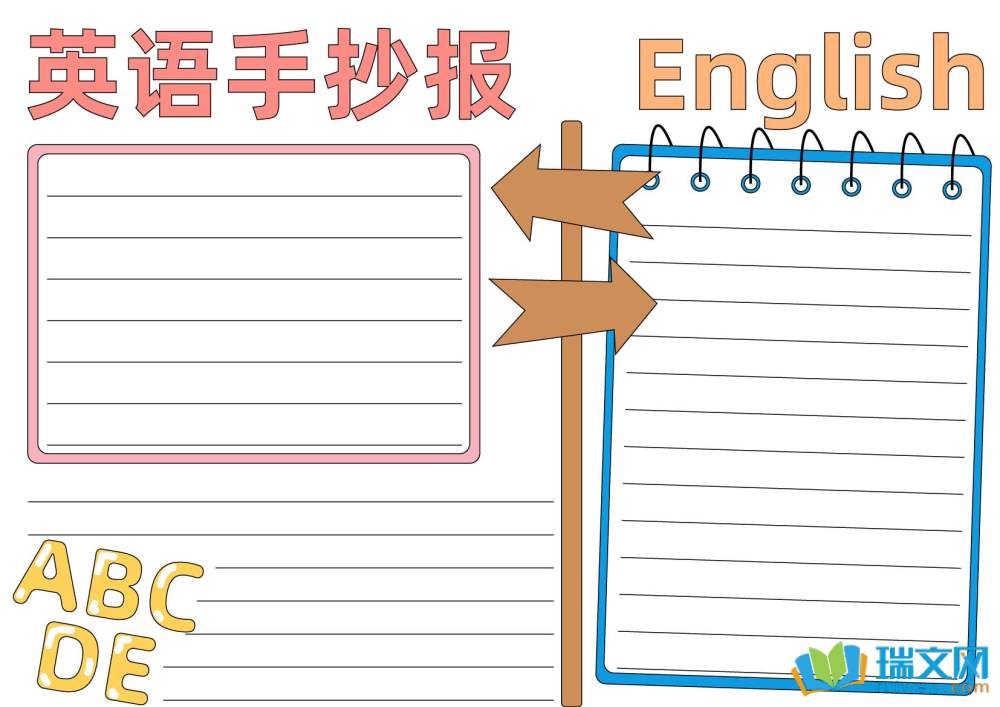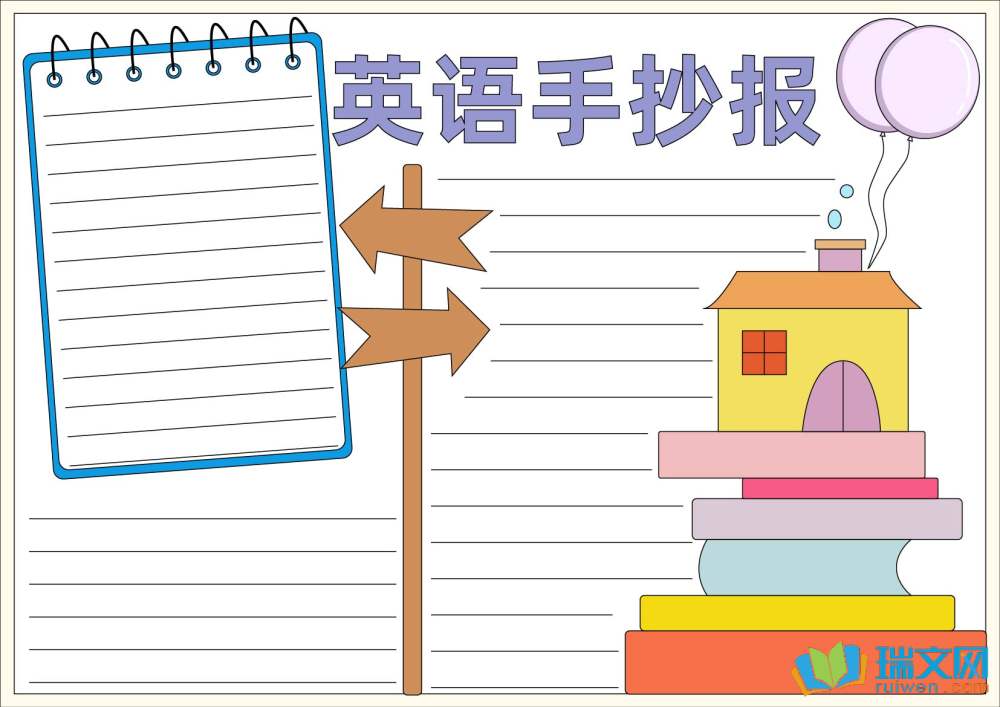小朋友们,大家知道哪些日常英语口语对话以及英语主要句型?下面就是收集相关的英语手抄报资料内容,欢迎大家阅读!
小学生英语手抄报资料





1. Hello, … 你好。
2. Hi, … 喂,你好。
3. Good morning/ afternoon/evening. 早上/下午/晚上好。
4. How are you(this morning/afternoon/evening)? 你今天早晨/下午/晚上好吗?
5. Fine, thank you/ thanks. 我很好,谢谢。
6. Not bad, thank you. 不错,谢谢。
7. Welcome back to school. 欢迎回到学校来。
8. Welcome to our school. 欢迎到我们学校来。
9. Happy birthday! 生日快乐!
10. What’s your name, please? 你的名字是什么?
11. Your name, please? 你叫什么名字?
12. My name is…/ I’m… 我的名字是…/ 我名叫…
13. This is Miss/ Mr/ Mrs… 这位是…小姐/先生/女士。
14. This is my friend. 这是我的朋友。
15. Come and meet my friends. 过来见见我的朋友们。
16. How do you do? 你好。
17. Nice to meet /see you. 很高兴认识/见到你。
18. Goodbye. 再见 19. Good night. 晚安。
20. How old is he? 他多大了?
第一册
1、I am …. She ’s …. We ’re …. They ’re ….
I am Tom. She ’s my friend. We’re friends. They’re friends.
2、This is •••. This is Tom . This is a dog.
3、Give me … Give me a ruler . Give me some pens.
4、What’s this /that ? It’s a •••
5、What does •••do ? She’s/He’s •••.
What does she do ? What does your mother do ? She’s a nurse.
6、How many ••• can you see ? I can see …
How many cars can you see ? I can see two cars .
7、Is this a •••? Yes ,it is ./ No ,it isn’t .
Is this a duck ?
8、May I have …? Yes ,here you are .
May I have a pear ?
May I have eight apples ?
9、How are you ? Fine ,thank you .
10、Point to …. Point to the blackboard.
11、Come to …. Come to the blackboard.
12、Draw …. Draw an apple.
13、Look at …. Look at the blackboard.
第二册
1、 What’s your name? My name’s•••.
2、 Are you •••? Yes, I am. /No, I’m not. Yes, we are. /No, we’re not.
Are you a new student?
Are you Amy and Lucy?
3、 Nice to meet you. Nice to meet you, too.
4、 Are they •••? Yes, they are. /No, they aren’t.
Are they Amy and Lucy?
5、 Who’s that? That’s my •••.
Who’s that? That’s my father.
6、 Is she •••? Yes, she is. /No, she isn’t.
Is she your sister?
7、 Is he •••? Yes, he is. /No, he isn’t.
Is he your brother?
8、How old •••?
How old are you? I’m ten.
How old is he ? He’s ten.
How old are they? They’re ten.
9、What’s the time? It’s four o’clock.
10、Thanks. /Thank you. Not at all.
11、These are•••. Those are•••.
These are trains. Those are planes.
12、What are these/those? They’re •••.
What are these? They’re books.
What are those? They’re pens.
13、What colour is ••• ? It’s ••• .
What colour is the plane? It’s blue.
14、What colour are ••• ? They’re •••.
What colour are the planes? They’re blue.
15、Where is ••• ? It’s •••.
Where is the football? It’s in the box.
16、Where are ••• ? They’re •••.
Where are the footballs ? They’re in the box.
17、 How many •••are there •••? There is•••. / There are •••.
How many doors are there in the classroom?
There is a (one ) door in the classroom.
There are two doors in the classroom..
There be 结构主要用以表达"某处(某时)有某人(某物)",其基本句型为"There be + 某物或某人 + 某地或某时",其中there 是引导词,没有词义;be是谓语动词;"某人或某物"是句子的主语;"某地或某时"作句子的状语,多是介词短语。如:
There is a football under the chair. 椅子下面有一个足球。
主语是不可数名词或单数可数名词时用is, 是复数时用are。如:
There is a flower in the bottle. 瓶里有一朵花。
There is some money in the purse. 钱包里有些钱。
2. 若句子中有几个并列的主语时,be的形式依据”就近原则”。如:
There is a boy, a girl and two women in the house. 房子里有一个男孩,一个女孩和两个妇女。
There are ten students and a teacher in the office. 办公室里有十个学生和一个教师。
3. 另外,在陈述句中为了强调地点,也可将介词短语提置句首。如:
In the tree there are five birds. 树上有五只鸟。
There be 结构的句型转换
否定句
there be的否定式通常在be后加not构成(在口语中be时常与not缩写在一起)。如果句中有some,一般要变成any。如:
There are some children in the picture. →There aren't any children in the picture.
一般疑问句及其答语
把be提到there前,首字母大写,句末用问号即可。其肯定答语是Yes, there is / are;否定答语为No, there isn't / aren't。如:
—Are there two cats in the tree?
—Yes, there are. (No, there aren't.)
特殊疑问句及其回答
①提问句子的主语(包括主语前的`修饰语)时,句型一律用"what is + 地点介词短语?"(无论主语是单数还是复数都用is)。如:
There are some birds in the tree. →What's in the tree?
②就there be后面的地点状语进行提问时,句型用"where is / are + 主语?"如:
There is a car in the street. →Where is the car?
③提问可数名词(主语)前的数量时,用how many,句型结构为"how many + 复数名词 + are there + 其它?"(主语无论是单数还是复数,be通常要用are)。
18、Is there •••? Yes, there is. / No, there aren’t.
Is there a playground in the school?
19、Are there ••• ? Yes, there are. /No, there aren’t.
Are there any flowers in the garden?
20、Whose ••• is ••• ? It’s •••.
Whose blouse is this? It’s Mary’s blouse.
21、Whose blouses •••? They’re •••.
Whose blouses are these? They’re Mary’s blouses.
22、I ( don’t ) have •••. I ( don’t ) have a fork.
You ( don’t ) have •••. You ( don’t ) have a spoon.
We ( don’t ) have •••. We ( don’t ) have two bowls.
They ( don’t ) have •••. They ( don’t ) have two glasses.
23、Do you have •••? Yes, I do. Yes, we do. / No, I don’t. No, we don’t.
Do you have a fork?
24、Do they have •••? Yes, they do. /No, they don’t.
Do they have a fork?
25、He / She has •••. He / She has a new room.
He / She doesn’t have •••. He /She doesn’t have a new room.
26、Does he /she have •••? Yes, he /she does. No, he/she doesn’t.
Does he/she have a radio?
27、How many ••• does ••• have? He/She has •••.
How many sisters does Lucy have? She has one.
28、How many ••• do ••• have? I/We/They/You have •••.
How many sisters do you have? I have two.
- 相关推荐
【小学生英语手抄报资料】相关文章:
英语手抄报资料09-11
英语手抄报资料翻译05-23
关于童话的英语手抄报资料03-19
国庆节手抄报资料英语10-08
母亲节英语手抄报资料05-09
国庆节英语手抄报资料10-12
小学生语文手抄报资料04-30
关于新年的英语手抄报资料02-07
英语春节的手抄报资料03-22